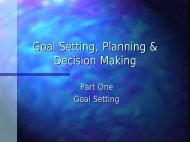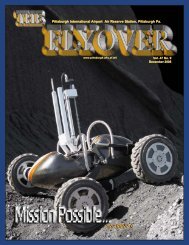Goal Setting, Planning and Decision Making
Goal Setting, Planning and Decision Making
Goal Setting, Planning and Decision Making
Create successful ePaper yourself
Turn your PDF publications into a flip-book with our unique Google optimized e-Paper software.
• Brainstorming<br />
This is a technique, generally done in a group, but can be done singularly, for<br />
developing creative <strong>and</strong> unusual solutions to problems. The process is free<br />
wheeling <strong>and</strong> uncritical. The concept is to generate ideas <strong>and</strong> approaches<br />
that are deliberately strange. These will inspire unusual solutions that can be<br />
developed by either logical thought or further brainstorming.<br />
1. What is brainstorming<br />
Brainstorming is a method for developing creative solutions to<br />
problems. It works by focusing on a problem, <strong>and</strong> then deliberately<br />
coming up with as many deliberately unusual solutions as possible <strong>and</strong><br />
by pushing ideas as far as possible.<br />
One approach to brainstorming is to “seed” the session with a word<br />
pulled r<strong>and</strong>omly from a dictionary. This word can be used as a<br />
starting point in the process of generating ideas.<br />
During the brainstorming session there is no criticism of ideas – the idea is to<br />
open up as many possibilities as possible, <strong>and</strong> break down preconceptions<br />
about limits to the problem.<br />
Once this has been done, the results of the brainstorming session can be<br />
analyzed <strong>and</strong> the best solutions can be explored either using further<br />
brainstorming or more conventional solutions.<br />
2. How to brainstorm<br />
The following rules are important to brainstorming successfully<br />
• A leader should take control of the session, initially defining the problem to be<br />
solved with any criteria that must be met, <strong>and</strong> then keeping the session on<br />
course. He or she should encourage an enthusiastic, uncritical attitude among<br />
brainstormers <strong>and</strong> encourage participation by all members on the team. The<br />
session should be announced as lasting a fixed period of time, <strong>and</strong> the leader<br />
should ensure that no train of thought is followed for too long. The leader<br />
should try to steer it towards development of some practical solutions.<br />
• Participants in the brainstorming process should come from as wide a range of<br />
disciplines as possible. This brings many more creative ideas to the session.<br />
• Brainstormers should be encouraged to have fun brainstorming, coming up with<br />
as many ideas as possible, from solidly practical ones to wildly impractical ones in<br />
an environment where creativity is welcomed.<br />
• Ideas should not be criticized or evaluated during the brainstorming session.<br />
Criticism introduces an element of risk for a group member in putting forward<br />
21
















